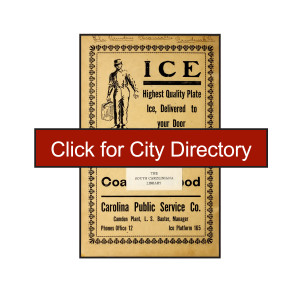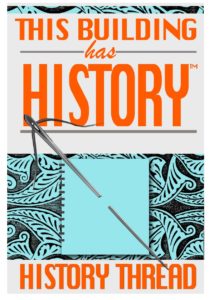City Directories and History: Enjoy added information at the National Register sites.
Hibernian Hall is the only extant and authentic building significantly associated with the Democratic Convention of 1860 at Charleston – one of the most critical political assemblies in the Nation’s history. At Charleston, the fate of the old party system was sealed – the Democratic Party was shattered and Republican victory assured in the fall. Hibernian Hall served as headquarters for the faction supporting Stephen A. Douglas, the pivotal personality of the convention. Completed in 1840, Hibernian Hall was the first semi-public structure of pure Greek type in the city of Charleston. It has a front colonnade of six Ionic columns surmounted by a pediment. The entrance leads into large stair hall, centered by an open rotunda covered by a dome with coffered panels, supported by superimposed columns of the three Greek orders. The pediment collapsed in the earthquake of 1886 and was replaced by one with modillions of the Corinthian order and center circular-arched window. Listed in the National Register November 7, 1973; Designated a National Historic Landmark November 7, 1973. [Courtesy of the SC Dept. of Archives and History]

Image ca. 1940s, courtesy of the Coleman – Meek Collection.
HIBERNIAN HALL
Designed 1835; constructed 1839-41; earthquake repairs 1887
Thomas U. Walter, architect; John White, stonecutter; Andrew Cunningham, carpenter; George Thompson, bricklayer
“The hall of the Hibernian Society was built for an organization that was established in 1801 to provide aid to Irish immigrants and their families and that was the result of the amalgamation of two earlier Irish fraternal orders. The organization eventually attracted men of wealth and power, not necessarily of Irish origin, and welcomed both Protestant and Catholic members. The Hibernians hoped to follow the examples of the halls built for the South Carolina Society and the St. Andrew’s Society and discussed the matter for fourteen years before buying a lot on Meeting Street. Architect Thomas U. Walter of Philadelphia, noted later for his design of the Capitol dome in Washington, D.C., was paid $ 100 in 1833 for plans for a building. Construction commenced on the hall in 1 839 and was complete by January 1841 at a total cost of $40,000.
The exterior, with its Ionic portico, reflects the simple and chaste design requested by the committee, save the gilded Irish harp in relief over the door. The interior, however, is an exciting space, dominated by a rotunda of three stories surrounded by stairs and circular columned balconies; the ceiling is finished with a coffered dome and oculus. Although the exterior portico was rebuilt after the earthquake of 1886 and changes included altering the proportions of the columns, as well as a more elaborate modillioned cornice and an Italianate window in the tympanum of the pediment, the building’s interior is largely unchanged. The site of numerous Hibernian functions, including its annual St. Patrick’s Day banquet, the building also hosts other large social events.
Since the years following the Civil War it has been the annual site of the January Ball of the St. Cecilia Society, Charleston’s oldest and most exclusive social function. On the portico stands a stone from the Giant’s Causeway, brought to Charleston from County Antrim, Northern Ireland, in 1851. An elaborate wrought-iron fence and cast- iron gas lamps enclose the property from the street.”
Information from: The Buildings of Charleston – J.H. Poston for the Historic Charleston Foundation, 1997

Other sources of interest: Charleston Tax Payers of Charleston, SC in 1860-61 and the Dwelling Houses of Charleston by Alice R.H. Smith – 1917
Other sources: Charleston Tax Payers of Charleston, SC in 1860-61, Dwelling Houses of Charleston by Alice R.H. Smith – 1917, Charleston 1861 Census Schedule, and a 1872 Bird’s Eye View of Charleston, S.C. The Hist. Charleston Foundation may also have additional data at: Past Perfect Charleston Library Society
Stay Connected
Explore history, houses, and stories across S.C. Your membership provides you with updates on regional topics, information on historic research, preservation, and monthly feature articles. But remember R&R wants to hear from you and assist in preserving your own family genealogy and memorabilia.
Visit the Southern Queries – Forum to receive assistance in answering questions, discuss genealogy, and enjoy exploring preservation topics with other members. Also listed are several history and genealogical researchers for hire.
User comments welcome — post at the bottom of this page.
Do you have information to share and preserve? Family, school, church, or other older photos and stories are welcome. Send them digitally through the “Share Your Story” link, so they too might be posted on Roots and Recall.
Thanks!
User comments always welcome - please post at the bottom of this page.














Share Your Comments & Feedback: